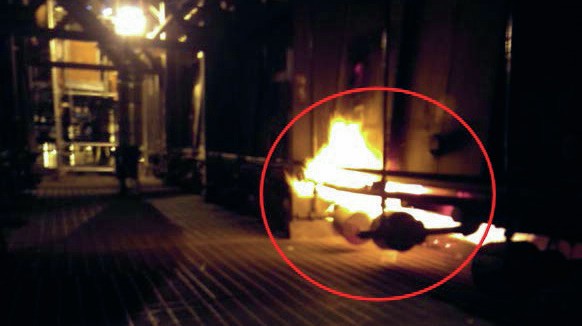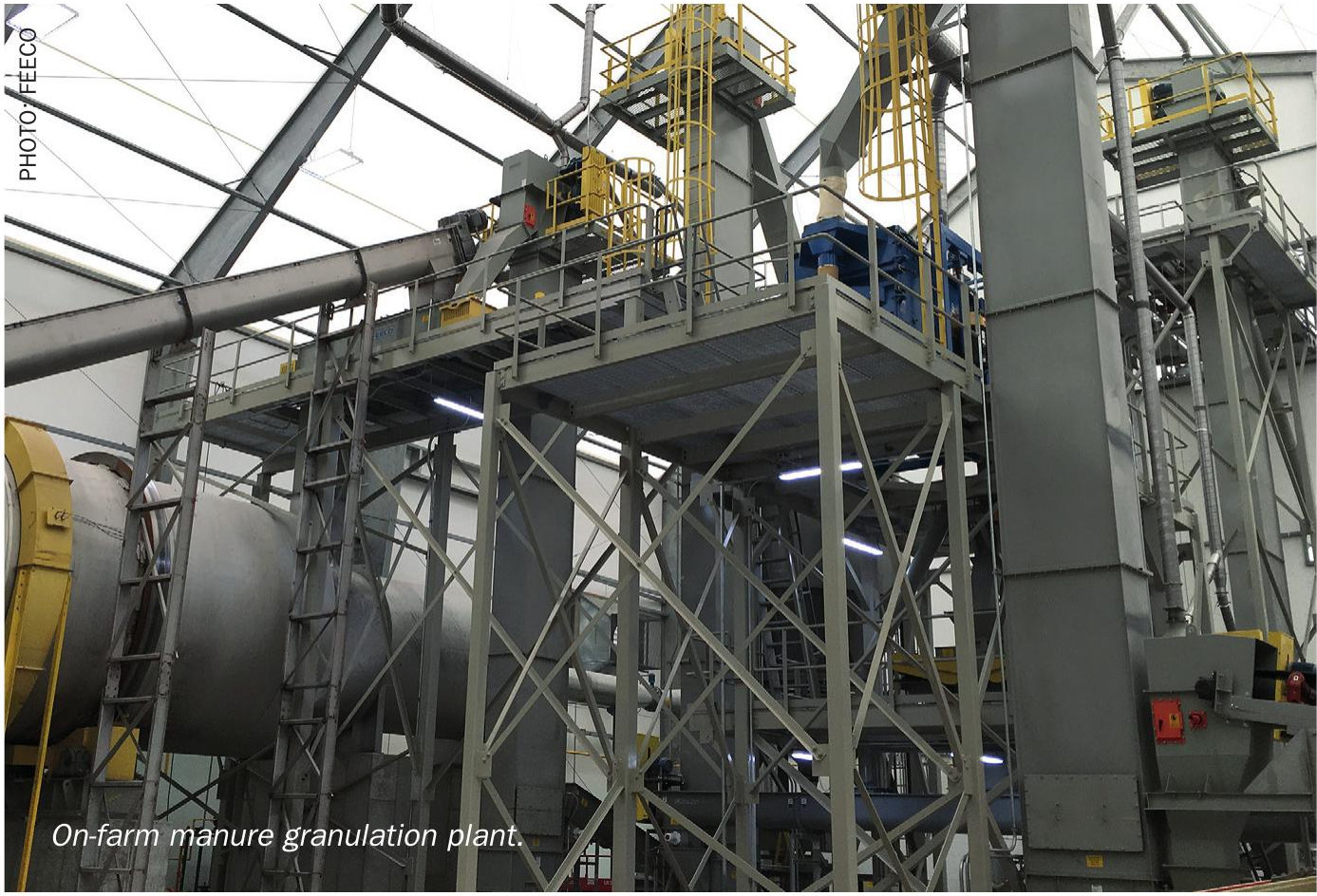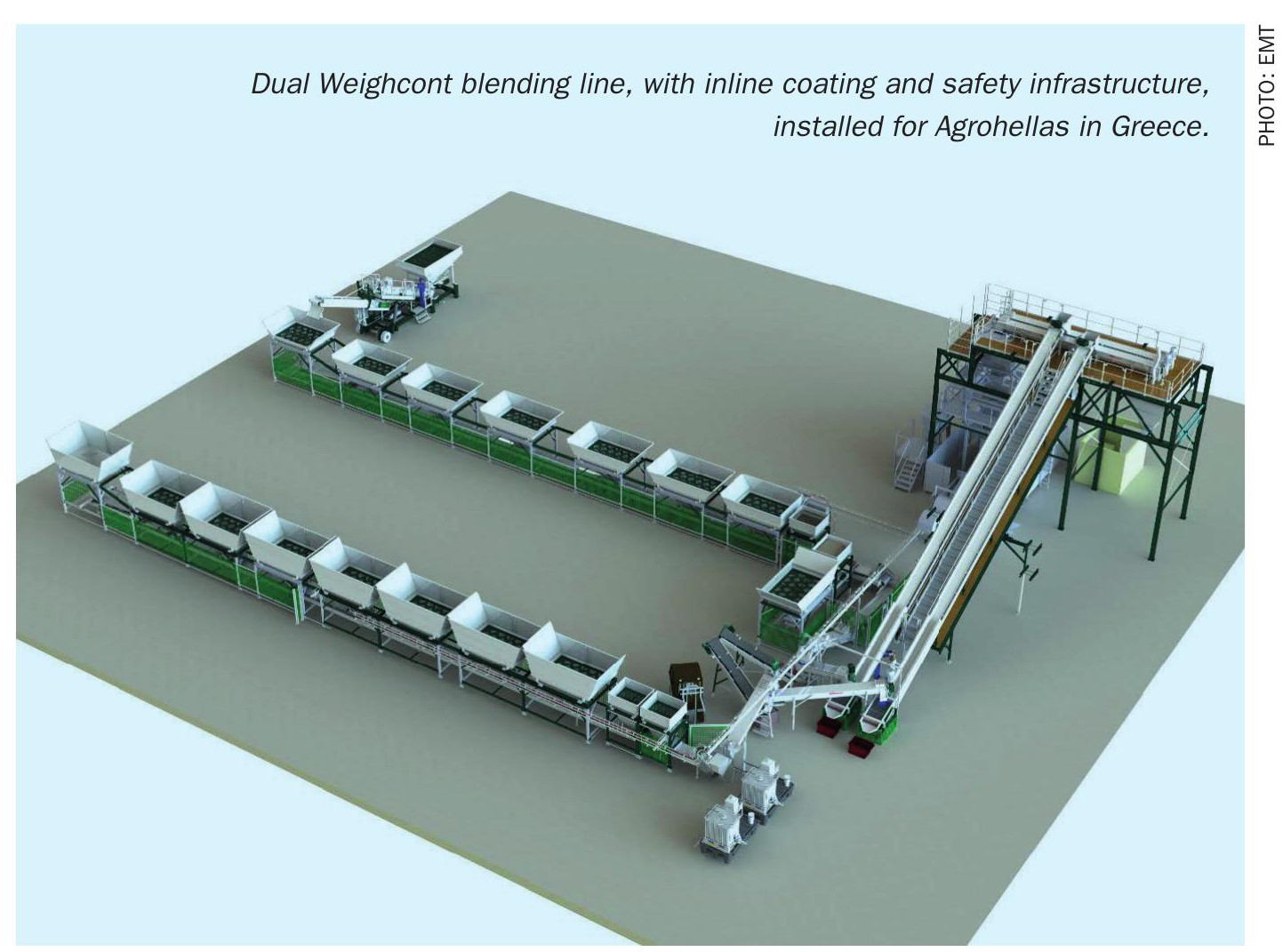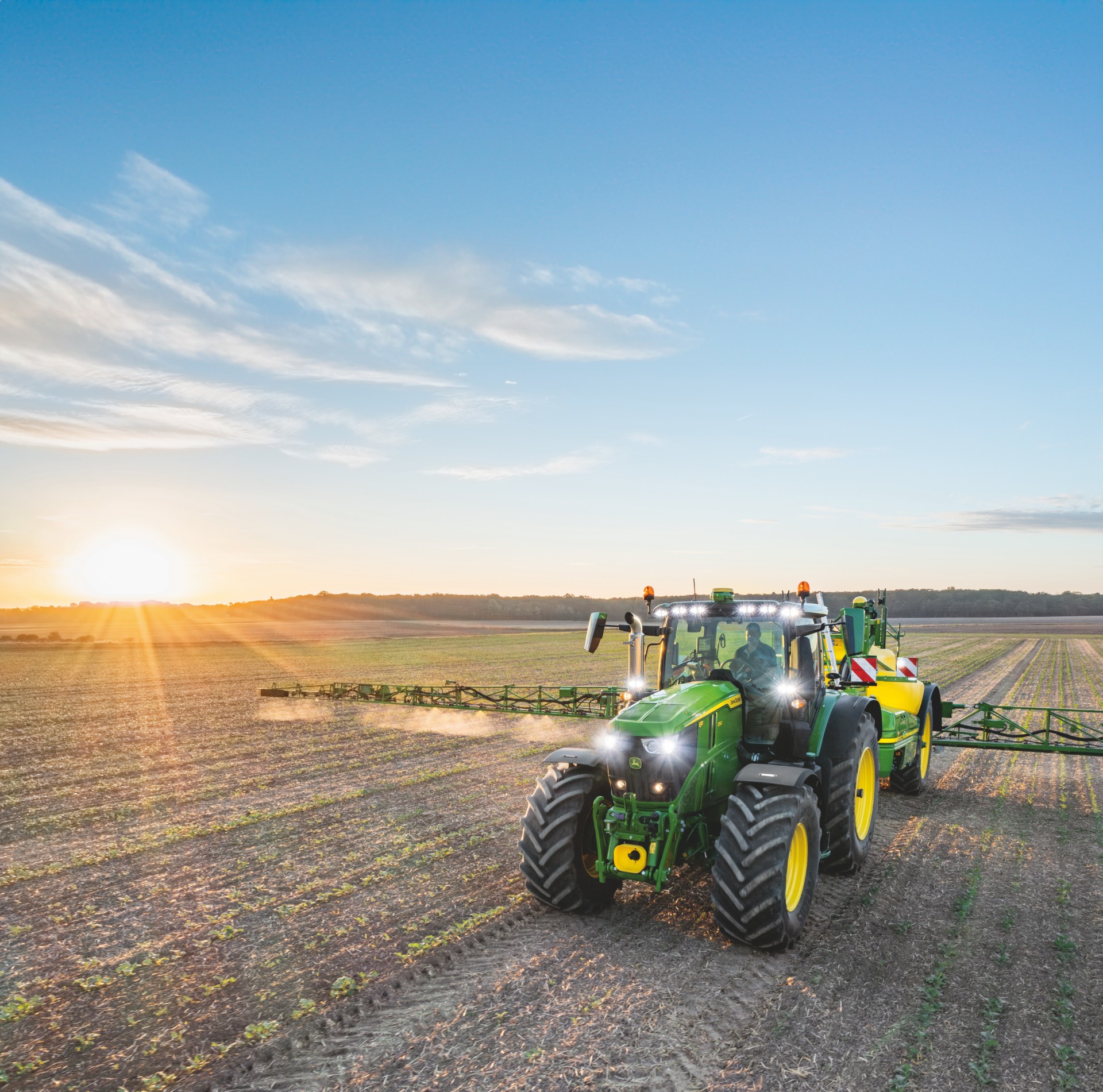Fertilizer International 503 Jul-Aug 2021

31 July 2021
Phosphate and potash grinding equipment
COMMINUTION TECHNOLOGY
Phosphate and potash grinding equipment
The crushing and grinding of mined phosphate rock and potash ore is a vital preparatory step for subsequent beneficiation and chemical processing. Although often overlooked, the efficiency of downstream P & K fertilizer production is heavily reliant on successful particle size reduction upstream.


In most forms of mining, the mechanical crushing and grinding of ore is the immediate next step after its extraction. Known as comminution, this is required to adjust particle size and/or liberate target minerals prior to beneficiation and downstream processing.
Grinding is a highly energy-intensive process, with the energy required (per unit mass) increasing rapidly as the desired particle size decreases. Power requirements depend on factors such as initial ore size, hardness and the final particle size required. For Florida phosphate rock, for example, around 35-40 kWh (per tonne P2 O5 ) of electricity is consumed during the grinding of phosphate ore concentrates.
Types of equipment
In the potash and phosphate industries, the main crushing and grinding equipment options include:
- Ball mills
- Jaw crushers
- Hammer, impact and cage mills
- Rod mills
- Roller mills.
Ball or rod mills are both heavy duty cylindrical devices able to reduce coarse-sized ore to a fine powder. Rod mills grind ore using the friction generated between particles and steel rods in a rotating drum, while ball mills, as their name suggests, rely on hard spheres as a grinding medium.
Ball mills can greatly increase the surface area and reactivity of materials and are usually operated as continuous processes in phosphate and potash grinding. Typical grinding media include ceramic balls, flint pebbles and steel balls. Forged steel and high chrome iron grinding balls are particularly common.
Phosphate grinding
Mined phosphate rock needs physical preparation before it is suitable for beneficiation and downstream chemical processing. Preparatory comminution and size separation are usually both necessary.
This can involve crushing, grinding and screening plus air classification or hydro-cyclone separation.
While froth flotation is widely applied as a beneficiation method within the phosphates industry, the pre-preparation of the phosphate rock differs significantly depending on the ore type.
In some sedimentary ores, crushing and screening are used to reject coarse hard siliceous material, while attrition scrubbing and desliming are used to remove fine clayey fractions. In Florida, the phosphate matrix is extracted with a dragline, placed into a pit and turned into a slurry with a water cannon. This slurry is then pumped to the beneficiation plant which can be located miles away from the mine.
Harder sedimentary ores, meanwhile, require a combination of primary crushing, secondary grinding and classification to liberate phosphate from the unwanted gangue. This comminution process is used to generate a suitable size fraction for froth flotation.
Much harder igneous phosphate rocks also need to be crushed and ground prior to froth flotation. This typically involves a primary crushing stage, followed by grinding in a rod mill in open-circuit and a ball mill in closed-circuit.
Potash crushing and grinding in Saskatchewan
Canadian potash deposits are concentrated in two distinct stratigraphic horizons. Mines in the Saskatoon area of Saskatchewan, for example, extract potash from the Patience Lake member, while those in the southeast of the province extract ore from the Esterhazy member.
Historically in Canada, around 90 percent of fertilizer-grade potassium chloride (muriate of potash, MOP) is produced by froth flotation (Figure 1), sometimes supplemented by heavy media separation.
The crushing, grinding and sizing of potash flotation feed is a compromise, according to metallurgists2 . Comminution needs to be carefully managed as, inevitably, there is trade-off between avoiding overgrinding – as the size of potassium chloride constituents need to be kept as large as possible for good flotation performance – while still effectively liberating halite and other insoluble constituents.
The run-of-mine ore produced by continuous mining machines is usually crushed underground with a jaw crusher to reduce the largest lumps to 15-20 centimetres in size. This minimises problems during underground transportation and skipping to surface2 .
Potash ore is a soft rock with typical Bond Work Index of 7-9 that can be prepared for flotation in wet or dry crushing plants. Dry crushing is generally carried out in a single stage using impactors in closed circuit with vibrating screens. More complex comminution circuits employ double-stage wet crushing in combination with wet screens and hydrocyclones. Dry crushing plants are simpler to operate but are often dirty due to poor dust collection. Wet crushing plants run much more cleanly and their screening is more efficient. They also remove insolubles more effectively2 .

Rougher flotation tails are usually re-crushed in a secondary wet crushing stage. The older circuit designs used rod mills for this purpose. Recent expansions and retrofitting of existing plants are replacing the old roll mills with rotating cage impactors. These are cheaper to operate, use much less space, have more capacity and generate less fines.
Beneficiated phosphate rock concentrates provide the feedstock for downstream phosphoric acid plants. Individual plants have distinct particle size requirements. These vary according to the reactivity of the phosphate rock feedstock and the type of process used. A fine powder with 60 percent less than 200 mesh (0.074 mm) is sometimes specified (Fertilizer International 434, p37).
The grinding of phosphate rock is generally essential for phosphoric acid production via the long-established and widely adopted dihydrate (DH) process. Rock grinding requirements are, however, less exacting for both the hemihydrate (HH) and hemi-dihydrate (HDH) processes, as a satisfactory reaction rate can be achieved with much coarser rock. Some phosphate rock feedstocks, such as those sourced from deposits in Jordan, Morocco, Senegal and Togo, are already fine enough for the HH and HDH processes without further grinding. The hemihydrate recrystallisation (HRC) process, meanwhile, requires a particularly fine rock grind (Fertilizer International 434, p37).
The primary purpose of comminution in phosphoric acid production is to create sufficient surface area to allow the rapid and complete digestion of the phosphate rock by sulphuric acid in the reactor. However, overgrinding, as well as wasting energy, can lead to hyper reactivity. It can also increase co-crystallisation losses due to formation of smaller and difficult-to-filter gypsum crystals.
The wet grinding of phosphate rock concentrates in ball mills is common practice in Florida and elsewhere (Fertilizer International 434, p37). Wet grinding keeps power consumption low and avoids dust generation.
Using gypsum pond water in wet grinding operations, to completely or partly replace service water, can generate further cost savings. Recycling pond water in this way avoids the substantial treatment costs otherwise required for its disposal or storage.
Recycled pond water is, however, acid and can cause excessive corrosion of the balls and metal liners during the wet grinding of phosphate rock. Consequently, the corrosion of forged steel or high chrome iron balls is a well-known phenomenon. Using water with a pH of at least 5.5 is therefore generally advised. pH can adjusted upwards by adding sodium hydroxide or ammonia, although this type of neutralisation adds to processing costs.
Metal grinding balls also undergo erosion, independent of pH, due to repeated abrasive contact with phosphate rock. The use of corrosion-resistant speciality steels and/or the neutralisation of pond water is therefore recommended to prolong the life of grinding media.
Wet grinding offers the following advantages over dry grinding:
- 30-40 percent reduction in energy consumption
- Eliminates the energy costs for rock drying
- Eliminates phosphate rock dust
- Reduces the size of grinding mills and their associated energy consumption.
Wet grinding can, however, create the following disadvantages at the phosphoric acid plant:
- Water in the slurry reduces P2 O5 concentration in the reactor. This dilution effect subsequently requires larger evaporators and therefore raises evaporation costs.
- Any reduction in the volume of water available for washing the gypsum filter cake will result in higher water-soluble P2 O5 losses.
- Overgrinding of soft, porous rock produces high viscosity slurries which are too fine. This ‘hyper active’ rock slurry yields very fine gypsum crystals which are difficult to filter.
Potash grinding
In conventional mining and modern beneficiation plants, potash ore is generally processed as follows1 :
- The ore is firstly ground to the size which liberates the target mineral sylvite (KCl) from unwanted halite (NaCl)
- The ore is next ‘deslimed’ to remove insoluble material and fines
- Coarser sylvite particles are then separated and recovered by froth flotation
- Some potash plants also beneficiate the ore using dry electrostatic separation (the ESTA process) or wet heavy media separation
- The beneficiated potash is dried and partly compacted to increase its size
- Fines are generally leached and recrystallised.
For potash, the size reduction process starts underground. Ore is usually crushed to less than 10-15 centimetres before being loaded onto conveyors. Some operations use hammer or impact mills to reduce the ore to below five centimetres before it is hoisted to the surface and delivered to the mill1 .

Once above ground, the ore is typically milled to a much lower size (below 2-4 mesh, roughly 0.5 cm) using high-capacity hammer, impact or cage mills in preparation for further processing. These are operated in a closed circuit with vibrating screens which return the oversize to the mill. Finer grinding with ball, rod or cage mills is then often necessary to achieve the desired halite-potash liberation size in the froth flotation feed1 .
In the two-stage milling of potash, while coarser grinding is usually carried out dry, finer grinding is often a wet process. To avoid overgrinding, finer grinding mills operate in closed circuit with screens or particle size classification equipment.
DSM (Dutch State Mine) screens – elliptical, near vertical screens with wedge-shaped bars – have traditionally been used for coarse size separation in these potash slurry grinding circuits. Oversize particles slide off the screen’s lower curved edge, while undersize particles and most of the brine fall through the screen. Hydrocyclones, hydroseparators and screw or rake classifiers are also used to remove slimes and for size classification of the flotation feed1 .
Equipment suppliers and projects
Leading manufacturers of phosphate and potash grinding equipment (Fertilizer International 434, p37) include:
- Bradley Pulverizer Company
- Comspain
- FLSmidth
- Köppern
- Ludman
- Metso Outotec
- Sandvik Rock Processing Solutions
- Sahut-Conreur
- Shanghai Jianye and Shanghai Zenith of China
- Terrasource (Gundlach and Pennsylvania Crusher).
Köppern is a leading supplier of potash compaction-granulation equipment. The family-run business, based in Hattingen, Germany, has been manufacturing briquet-ting, compaction and comminution machinery since 1898.
Granular potash is produced almost exclusively by the compaction-granulation process. Köppern has been supplying compaction and granulation equipment and plants to the fertilizer industry for more than 70 years. Its sales include several hundred roller presses in over 60 countries (Fertilizer International 501, p55).
Dusseldorf-based Loesche GmbH is a leading designer and supplier of milling plants based on vertical roller mill (VRM) technology. The company completed and commissioned a 650,000 t/a phosphate rock grinding plant for EuroChem at Zhanatas in southern Kazakhstan in 2016. The plant uses Loesche’s LM 24.2 model VRM mill for the primary treatment of phosphate ore from the Kok-Djon deposit in the country’s Zhambyl region.
VRMs are suitable for the dry comminution of hard phosphate ore, according to Loesche, being able to produce “a consistent, dry product in a difficult environment”.
Loesche has installed more than 2,500 VRM machines worldwide. These are typically used for the dry grinding of coal, cement raw materials, granulated slag, industrial minerals and ores. Loesche has often been the first company to introduce VRM technology into new industrial sectors – including several installations for grinding phosphate rock and phosphate rock concentrates.
EuroChem is developing the Kok-Djon deposit in two stages. The initial crushing, drying and grinding plant – which consumes phosphate rock mined from a nearby open pit – came on stream in 2016. This will ultimately supply a large-scale phosphate fertilizer plant. EuroChem signed an investment agreement with Kazakhstan’s government to build and operate a new $1 billion fertiliser plant in the country’s Zhambyl region at the beginning of last year.
TerraSource is the owner of the three flagship equipment brands Gundlach, Pennsylvania Crusher and Jeffrey Rader. Collectively, these brands have supplied many of the impact crushers, cage mills and roll crushers employed by the global potash industry.
Indeed, TerraSource has a long history of partnership with leading phosphate and potash producers. To the extent that the company has installed crushing equipment for all the major potash producers in North America as well as having a significant presence at potash operations in Russia, Australia, South America and the Middle East.
Gundlach, which has been an equipment supplier to the North American potash industry since 1967, offers both wet and dry crushing equipment. Notable potash industry models include the:
- 4000 Series roll crusher for raw potash ore
- 2000 Series roll crusher for breaking flake from the compactor
CASE STUDY
Gundlach Nanosiz-R® roll mill
Jack Vivrett of TerraSource explains how the company is bringing innovation to the potash industry through its partnership with Intrepid Potash.
Intrepid Potash relies on TerraSource crushers at multiple operations. But the company’s conversion to our Gundlach Nanosiz-R® roll mill at one of its Utah sites has helped make that operation one of the lowest cost potash production sites in the world – with the highest efficiency in the industry from compaction to final product.
The Nanosiz-R offers ‘bi-modal’ crushing for friable materials – as it functions through both shear and compression. Its modular design means that multiple units can be configured in series, if necessary, to achieve greater size reduction ratios.
For materials with a bulk density of 70 lbs/ft3 , the standard version of a Nanosiz-R can crush up to 65 short tons per hour (st/h), while the high-capacity version can crush up to 130 st/h, reducing feeds to a 2-4 mm size product.
At Intrepid’s Utah plant, the company harvests potash from evaporation ponds, crushes this and then pumps this as a slurry some eight kilometres back to a mill for further processing.

For this process to work productively and seamlessly, Intrepid needed machinery capable of crushing 3,500 t/d of very wet mill feed from its raw size of 12-19 mm down to 1-2 mm size.
Although many impact crushers can produce material this fine, these types of machines typically produce too much oversize. In contrast, the precise hydraulic adjustment of rolls possible with Nanosiz-R machines – which offer a roll gap accuracy of a thousandths of an inch – enables operators at Intrepid Potash to fine tune the very tight roll gap they need. These Gundlach machines also efficiently eliminate the large size materials that can create a lot of rolling resistance in a slurry line.
- Cage-Paktor cage mill for polishing oversize material from screens
- Nanosiz-R roll mill, which is used for sizing oversize potash material discharged from screens (see case study).
Jeffrey Rader Flextooth hammer mills are also used to break down raw ore. Their energy efficient design and longer wear life makes them ideal for high-capacity crushing at low speeds. Flextooth mills work in tandem with proprietary Slant-Flow screen grates. These deliver a more uniform product size, evacuate material faster and minimise clogging, all with less wear on grates.
Pennsylvania Crusher has installed more than 6,500 crushers in 79 countries. The company’s double toggle jaw crusher is ideally suited to bigger and harder grades of phosphate rock. This effective and rugged compression crusher offers a power-efficient method for the sizing of hard or abrasive materials that can cause excessive wear with other types of crushers. Being designed with balanced moving parts, these machines do not require massive and costly foundations, unlike other types of compression crusher.
TerraSource equipment has a reputation for durability and efficiency. They are also well known for their ability to precisely size a wide variety of raw materials, whatever their hardness, composition and moisture content. Every installation is backed by in-depth engineering and application know-how and rapid-response service support. Comprehensive materials testing and analysis capabilities are also provided by the company’s innovation centre in South Carolina.
Metso Outotec installed a custom-built mill at Yara’s Suomi phosphate mine in Siilinjärvi, Finland, in 2018. The finished rod mill was installed at the site’s phosphate concentration plant during its annual shutdown.
The new 4×6 metre rod mill was designed so that it could be installed directly on top of the bearing housings of the old mill, which dated from 1979. This meant Yara was able to utilise the existing mill’s power transmission line, gearbox and foundations in the project. The original gearbox was, however, given a thorough overhaul during the shutdown.
Metso’s contract with Yara also specified the design and manufacture of a new 350 tonne capacity installation cradle, to allow the mill and its contents to be lifted whenever necessary.
The mill, which weighs more than 150 tonnes, was transported to the mine on a 14-axle trailer in the week preceding the shutdown. On arrival, it was lifted into place with a massive lattice boom crane.
“We received a new custom-built mill at half the cost of what a standard mill [with] new power transmission, electrification and foundations would have cost us,” said Antti Savolainen, the manager of Yara’s Siilinjärvi phosphate concentration plant.
“The old equipment’s replacement with a finished mill [was] carried out in 10 days during the annual shutdown. Given the strong demand for our concentrate, and a daily production volume of around 2,800 tonnes, this was well worth the investment,” Savolainen added.
The new mill was fitted with 800 grinding rods following a successful pressure test. This allowed the grinding of phosphate ore to recommence on schedule when production resumed. The 500 t/h capacity mill now works 24/7, grinding the 25 mm ore feed using 1,250 kW of power.
“We want to rely on our partners and the know-how they provide. Metso has a good track record at Yara’s Siilinjärvi mine. It supplied the linings of primary gyratory crushers and deliveries for the installation of an MP800 cone crusher,” said Savolainen.
He concluded: “It looks like this custom-built mill was also the right solution. Our target is for the new mill to grind phosphate ore at our mine with a 99.9 percent utilisation rate for the next 30 years.”
References






